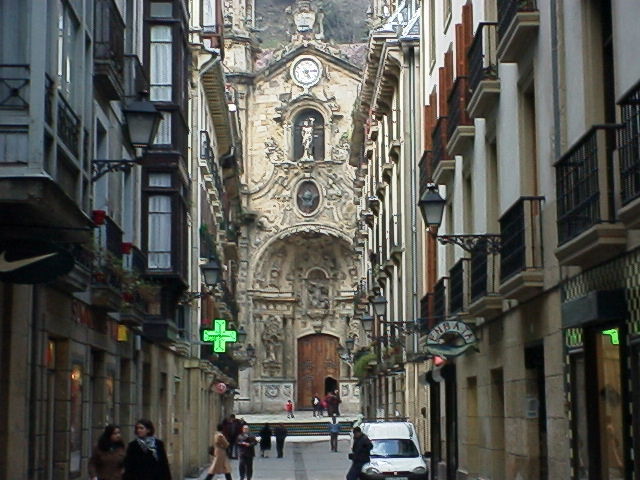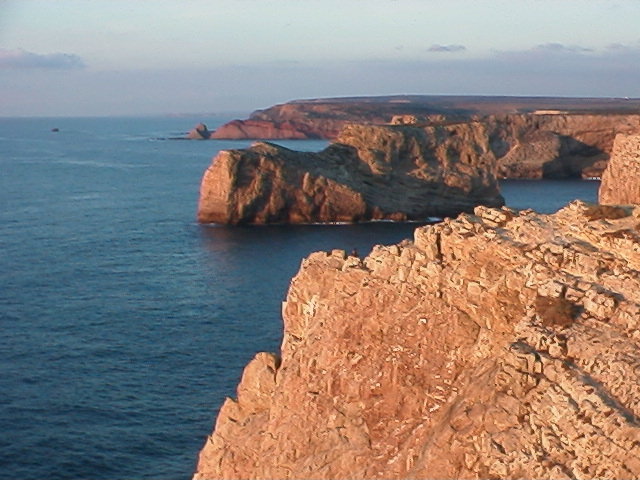
Around the World in 1998-1999; Portugal

Note; this post is recreated from the original wired2theworld website post with the dates below. The old posts were reformatted for the 20th anniversary of wired2theworld. As much as possible, the content is unchanged and unedited from the original, only some formatting, spelling, and link errors have been corrected.
Kristina’s Journal:
March 2, 1999
US$1= 180 escudos
Bem Vindo a Portugal!
This morning we drove from Santiago de Compostela to Portugal. There was no border, we just crossed a bridge over a river, and Welcome to Portugal!
The first town of any size we came to was Vila Nova de Cerveira where we went in search of the tourist office and an ATM machine since we had no Portuguese Escudos. The first three ATMs we tried were of no use, refusing to take the card altogether, even though the machines had Cirrus symbols on them. We started to get worried as everything was closed for lunch and it is a bit awkward and unsettling to be in a country with no hard currency. Finally, we found a machine that would take our card and give us money with the magic PIN number!
After that, we drove to the tourist office, hoping to find some information on the local area and on Pousadas since we were interested in staying in one during our time in Portugal. Pousadas are a government-owned network of historic buildings like castles and monasteries that have been converted into luxury hotels. Most were out of our price range, which we had checked on a few different sites on the internet, but still, we wanted to see what was available.
So, we sat in the parking lot of the tourist office, ate our usual picnic lunch out of the cooler, and waited for them to open. After the appointed opening time came and went, we had a startling realization; when we crossed the border, we suddenly gained an hour in the time change! Portugal is in the same time zone as London, one hour ahead of Spain. At this point, rather than wait another hour, we chose to move on to the next big town.
Table of Contents
Viana do Castelo
We arrived in Viana do Castelo, a town settled in the Middle Ages on the bank of a river and the edge of the Atlantic ocean, where we decided to stay for the night. The tourist office, once they opened, was immensely helpful offering all sorts of brochures on the area, on Pousadas, and a list of local Pensaos and Residencias.
We went to first Residencia recommended; the Pensao Residencia Jardim ( Largo 5 de Outubro, 68 tel. 058 828915/6) where we got an excellent room, complete with a view of the port, a balcony that rounded the corner of the building, a great bathroom, CNN, hard-wired phone (which meant no email), for 6000 esc ($33/night), including breakfast. From the list they gave us, this seemed to be the going rate in the area, 5500-8000 esc.
After we checked in, we did a little walking tour of the town to check out the medieval architecture and the azulejos, for which the Portuguese are famous. Azulejos are tiles, glazed and painted, which are used as decoration on small parts of facades or to face an entire building.
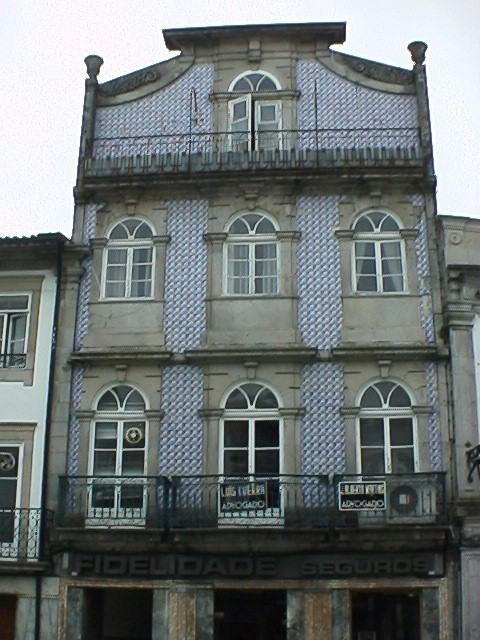
It is said that they originated in Spain, and the concept was brought to Portugal in the 15th century by King Manuel 1 who was impressed by the tiles he saw used to decorate the palaces in Andalusia. There are many different styles of azulejos, ranging from geometric patterns to large, richly detailed, scenic paintings.

They are often colored in only blue and white, but can also be found with every color of the rainbow. The Portuguese developed a standard 5.5 inch tile that is still in use today. We saw the azulejos used almost everywhere, covering entire buildings, and as decoration above windows and doors, and as large blocks of tile placed like paintings in the center of a wall.
In the center of town sits, of course, the main town square, complete with a fountain, an old town hall from the 16th century, and a 14th-century building that was once a private residence. The Se cathedral, only a few blocks to the south, is both Romanesque and Gothic in style. It is quite small, compared to others of its time, but what makes it interesting is the interior which was damaged by a fire in the 1800s. To cover the fire damage to the stonework, the cement was painted over and rendered to look like the old arches and decorative carving that had been there before. In the dim light, it is almost impossible to tell what is painted and what is not.
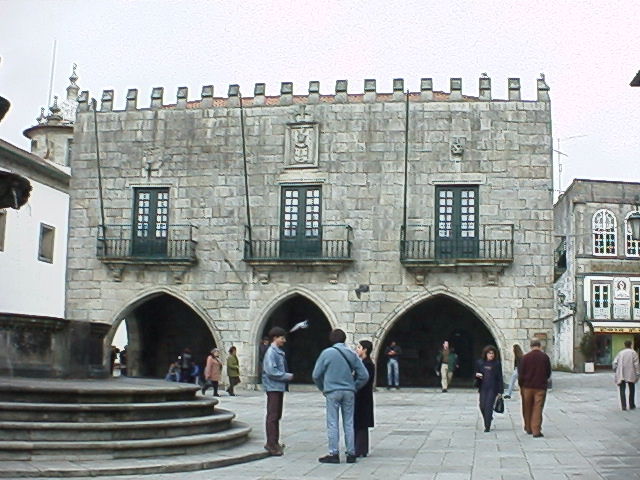
Late in the afternoon, after wandering for hours, we finally got brave, went into bar that looked friendly on a tiny back street, and ordered our first glasses of the local Port. While all the local grandmothers looked on at the obvious foreigners, we each had a wonderful glass of Tawny Port called Reccua for a total of 240 esc.
For dinner that night, we went walking around, peering into places that were near empty, or out of budget, until we came across a place that looked like a small local diner, complete with a counter, stools, and a few small tables. As we stood outside, an older couple walked by, obviously locals, and said to us in Portuguese, something like, “Go on, go inside, it’s good!” They practically pushed us inside. Well, with that recommendation, how could we refuse?
The place was called O Manel, and is located on the street directly one block behind our hotel. We were first served a basket of bread with a little pot of manna pate de sardinha which was, yes, sardine paste. It was fishy and salty, but not bad. I ordered an omolete de queijo e fiambre which turned out to be a cheese omelet with ham. It was good, just not what I expected; I thought he said salmon, not jamon, when I asked what fiambre was! I also tried the local house wine called vinho verde, literally “green wine” which is a young white wine with a slight effervescence. David had Rojoes a minhota, “Pork Minho style”, which was chunks of roast pork cooked with potato, pieces of stuffed tripe and blood sausage served with rice. Needless to say, it was “flavorful”, and he enjoyed it, but I think to most people, some of its components would be an acquired taste.

The next morning, before setting off for Porto, we drove up the hill to see the Basilica de Santa Luzia on top of the mountain. This church was built in 1926 but appears much older due to its mixed revivalist style. It sits directly in front of the ruins of a pre-Roman settlement and a Pousada called Monte Santa Luzia. There is a great view of the entire area from the plaza in front of the church.
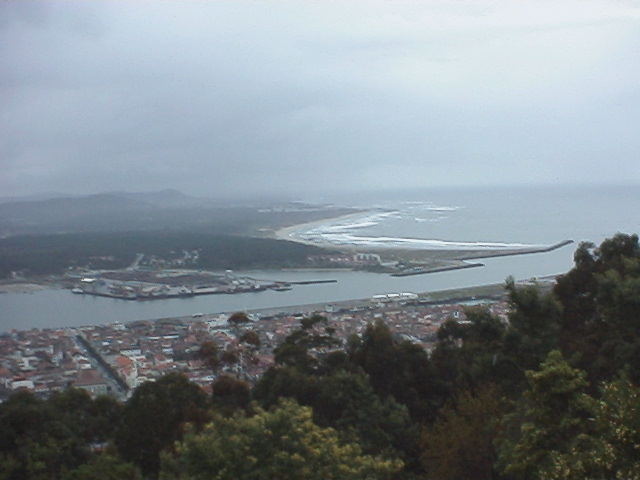
Porto Portugal
March 3-4, 1999
Of course, we arrived in the rain and wound up walking around town in the downpour looking for hotels we could afford, until, after 2 hours, we settled on one in a cute little square that was in our guidebook all along! The Pensao Sao Marino, (Praca Carlos Alberto, 59 tel. 3325499) is a nice place, very simple, but we had a room that looked directly out onto the square, over a wonderful smelling bakery.

All the buildings in the square were either completely faced with azulejos, or each was painted a different color making our view quite colorful. Our window allowed us to look down into the square and watch the comings and goings of the various residents, tourists, and transients.
It was here that we discovered a new way that some of the local homeless had come up with to “earn” money; they “helped” people park their cars. Like most cities, parking in Porto is at a premium, especially those spaces on the street, and in our square, people would often drive around in circles looking for space. And about every 50 feet or so, is standing a man, “directing” people into spaces as they open up. Sometimes the spaces are small and people need help getting their cars in and out, but oftentimes, it is not necessary to be guided into a parking space. No matter though, you can count on “help” and then a hand out for money from these guys!
The first time we parked here and were approached for money, we declined, not wanting to be bullied into giving someone money for an unasked for, and unneeded service. Then we stood in our window and watched these guys in action. We nicknamed these guys “black jacket guy” and “green sweater boy”. Every single person who parked gave them money! We were appalled until we noticed that these same people rarely paid for parking as they were supposed to (instead of meters, one goes to a ticket kiosk, puts in coins for the amount of time desired, and then places receipt in car window), they just went about their business, often not staying for more than a few minutes. Was this some sort of protection from the parking patrol, we wondered?
The following day, after returning mid-afternoon with the car, we too drove around in circles for almost 15 minutes waiting for a space to open up. Then finally, when one did, there was “green sweater boy” standing in the space, refusing to move! He was “holding” it for someone else who was double-parked. I swear, it was all I could do to prevent David, who was furious, from mowing him down with the car! Narrowly missing the man, and possibly an international incident, we pulled out of the space and relinquished it to the other waiting car.
The owner of our pensao, who had been standing in the doorway, witnessed this entire encounter. He walked over to his own car across the square, and proceeded to wait there until we came around the circle again, and then moved his car so we could have the parking space. He double-parked his own car in front of his front door. By the time we reached the front door “green sweater boy” was there bitterly complaining to the pensao owner. David told the owner he didn’t believe anyone had the right to hold the space and the owner concurred. We went upstairs and 20 minutes later, the man was still complaining, along now with his buddy, “black jacket guy”. The best part came, however, when the owner’s wife came out of the building, was told about what happened, and then smacked “black jacket guy” upside the head a couple of times before she went on her way across the square. End of incident.
David’s Diary:
The next day, we set off early to visit the Museo Romantico, a little known, beautiful old house that was the residence of the exiled king of Sardinia in the early part of the nineteenth century. Apart from the hoards of young children who were waiting for the museum to open, there did not appear to be any other tourists around. The house is quite well preserved and completely furnished with all the original pieces from King Charles Albert’s time. He passed away in the house in 1843, and it has not been changed since.
One of our main reasons for visiting the Museo Romantico was that in addition to the museum, it houses the Solar do Vinho do Porto. Downstairs from the museum portion of the estate, in what would have been the cellars of the King’s residence, is the Institute of Port Wine. It isn’t much more than a glorified Port bar, but it has an amazing selection of Ports of all the different varieties. It is an attractive place, nevertheless. The patio opens up onto the garden portion of the estate, which has a fantastic view of the river mouth and the sea. Across the river, one can see the Port Lodges, where all the Port wine is fabricated.
Unfortunately, the Solar do Vinho is more of a bar than a tasting museum, even though they have ports available that are older than my grandfather. I had hoped for a free sample or two, but alas, all wines are by the glass and priced accordingly. To sample a 100-year-old vintage Port could set you back upwards of 50 dollars US, and a cheap ruby runs as little as a buck.
We decided on two glasses of tawny port, each different, in order to make a comparison, and perhaps learn something. We chose a glass of Wiese & Krohn 10-year-old tawny, for about 2 dollars, and a glass of Taylor’s 20-year-old tawny for about 6 dollars. Both were quite delicious, but there was a discernible difference between the two. I’m not certain if the major difference was the Lodge it comes from or the age, but the Taylor’s 20-year-old tawny was just that much richer in flavor, and smoother in texture, almost velvety. The older Port had a slightly deeper color, a bit rustier looking, or tawny, I suppose. Overall, it was better.
If it didn’t come from here, it’s not really Port.
David’s Notes:
By tradition and law, if it is called Port, it comes from Porto and is made on the south side of the river in the area called Vila Nova de Gaia. All the lodges are located within a couple of square miles, along the banks of the Douro river. In addition, restrictions on where the grapes can come from limit all the Lodges to a small region of Portugal: the Douro valley. Yes, the name of the valley has to do with the river that runs through Porto. They are one and the same, only the grapes come from upstream in the mountainous regions of the upper Douro, and the production occurs next to the river mouth by the sea.

The Quintas, as the vineyards are known, cover the steep and fertile hillsides of the upper Douro valley, which has terraces as far as the eye can see. The only other places I have seen with as many terraced mountainsides are the mountainous rice paddies of Indonesia. For hundreds of years, the grapes haves grown on these hillsides, and been carried to lodges down the river by boat to be made into Port wine. The strategic importance of the locations should be clear, as exportation was via seaborne trade routes, primarily to the British.
Port is a fortified wine, meaning that it has brandy added to the mix. It was originally added to the wine in order to protect it in transit, but over the centuries, the process has been cultivated to fabricate some of the richest wine known to humankind.
We went from the Solar do Vinho do Porto straight across the river to the area known as Vila Nova de Gaia in order to visit a lodge, and hopefully to continue drinking the good stuff. The road is not easy to find, it is thin and it winds down the steep hillside around ancient buildings. When we finally reached the bottom and parked, we walked across the street to the most famous lodge of them all: Sandeman. Perhaps because of marketing, or perhaps thanks to their logo, a masked, Zorro-like figure, they are among the best known. However, they wanted to charge us about five dollars a piece and we would have had to wait about an hour then be given a tour in between groups of high school kids on a field trip.
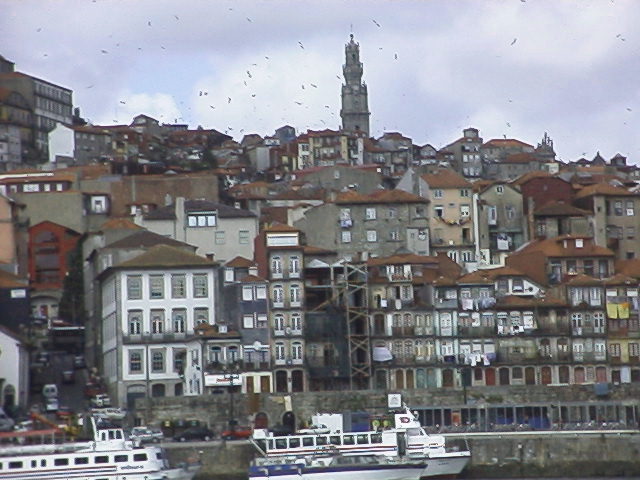
We buggered out of there in a hurry, and climbed the hill to Taylor’s, whose 20 year tawny we had just enjoyed. Taylor Fladgate is as famous as Sandeman, and ranks in Wine Spectator as one of the top ports in the world. It is about as old as they come, if not the first of big Port Lodges, although I think a few of them try to claim responsibility for being ‘the first’. Anyhow, Taylor’s is just a bit more classy than Sandeman, as was evidenced by their tourist operation.
In contrast to Sandeman, the Taylor’s reception did not look like the ticket booth for a ride at an amusement park, and nobody was wearing a costume, mask, or cape. There were no kids, or other tourists, for that matter, to wait behind. We arrived and were given a personal tour, in the company of one other visitor, a young woman from New Zealand, traveling alone. The tour was free and very informative. I learned more about Port in that hour than I had learned about the wine in 30 years.

For example, 10, 20 , 30 , and 40 year tawnys are actually blends of Port from all all different years, carefully mixed to achieve that ‘just so old’ flavor and texture. The master blenders (people, not machines) use a mix of younger, older, and very very old wines, all aging in wood casks at the lodge, in order to garnish all of the characteristics desired. A 40 year old tawny is not really 40 years old. It is a blend of 10s, 14s, 20s, and a little bit of 150 year old Port, maybe. There is always a mix of the very very old, at least 60-80 years if not twice that, with the much younger ports. I did not know that. The only Ports which are 100% as old as they say on the bottle are the Vintage ports and Single Quinta ports. Because it is fortified, Port is capable of aging well beyond 100 years in wood, or in a bottle without turning.

Vintage Ports are the finest, and are only aged for two years in wood, then are bottled and cellared for 10- 50 years, until they are ready for release. A single Quinta is a distinction that indicates that a Port wine has not been blended, either with another year’s Port or, specifically, with another Quinta, or vineyard’s port. Thus, a single Quinta comes from one small plot of land, where the harvest for that year was exceptional and is only aged for about 8-10 years before release on the market. In general, the quality of Single Quintas is not as high level as the declared vintage years.

After our delightful tour, we were escorted to the tasting lounge and given two heft glasses each, one white chip dry Port- an aperitif wine, and the other a tawny. Both were fabulous, and both were free.
We like Taylor’s a lot, and recommend that if you are Porto, you skip Sandeman’s and head up the hill to Taylor’s, a first-class outfit. We also recommend that if you can afford it, you buy a bottle of their 10 or 20 year tawny, as it is great! Of course, if you can afford it, get a Quinta or vintage port as old as you are! Why not, it’s only money!
Kristina’s Journal:
We sat for about an hour in the lounge at Taylor’s, sipping the port, and chatting with the woman from New Zealand who had been on the tour of the Loggia with us. She was an elementary school teacher who was traveling alone for a few weeks through Spain and Portugal. As it turned out, she was staying in the same pension as us and we agreed to meet and have dinner together later that night.
Since David and I had endured possibly the worst dinner in history the night before, we were wary of a repeat performance. We walked around the square and settled on a restaurant that looked decent. We went in, sat down, and asked for a menu. The waiter informed us that there wasn’t one and gave us a few items verbally to chose from.
All went well until dessert came. We had ordered “chocolate mousse” as our last choice and it was completely inedible. It has the consistency of gooey glue. We just sat there and looked at it, not able to eat it. When the waiter came, we told him we didn’t want it, or anything else. He took it back to the kitchen window where it was examined closely by the women behind the counter, and then dismissed with a “Hmmph!” I guess we insulted them, but better to do that than to be sick for the rest of the evening. We paid the bill and quickly left.
David’s Diary:
March 5-6, 1999
Lisboa
Miracles seem to happen everywhere in Europe, and when they happen with some regularity, a site for pilgrimage is almost always established.

We stopped in Fatima on the way down to Lisboa from Porto. Fatima is considered a major site, where pilgrims arrive on their knees on the 13th of October and May. In 1917, on May 13, the Virgin appeared to three shepherds. Odd coincidence that there should be three of them, and that they just happened to be shepherds. Legend has it that the virgin continued to appear on the 13 of each month until October 13, where she came for the last time, before a crowd of 70,000 people who witnessed the last miracle, the appearance of the sun on a rainy day, spinning like a ball of fire.

As far as miracles go, we saw none, but I lit a candle for the spirits of all the little birdies who have met their untimely demise against the front of our fast-moving vehicle. One little birdie in New Zealand, against the windshield; one in the radiator grill in France, which Kristina had to scrape out with a stick three days after the fact; the last one against the windshield in Spain. Sorry. The good news is that since that gesture, we have not been involved in any further road kill.
We arrived in Lisboa shortly after a picnic lunch in Fatima, with Kristina performing a successful navigation of the city center. After the usual walking around and comparing pensions, we settled into the Residencial Florescente (Rua Portas Santo Antao, 99, tel. 3463517) one of the ones that were in the book. The room was nice but pricey. Big cities are always more expensive. It also bore the mark of our tribulations: scaffolding. It was being erected even as we checked in, and they had covered the first three floors by sundown, our room included. It was at once reassuring and annoying, as we knew that we were clearly meant to stay there, however, the presence of construction workers outside the window is always a bit of a pain in the neck.

En route to dinner that first night, we stumbled upon what would turn out to be the most significant discovery of our visit to Lisboa.
We noticed a tiny little bar, no wider than its doorway, that was doing incredible business. We try to keep our ‘locals’ radar on at all times, in search of those things and places that are popular and frequented by the natives, not the tourists, and this place lit up all our screens. There was a theatre or music hall directly across from the hotel, and something was on this evening. On their way to the theatre, throngs of people were stopping into this doorway for about 2-4 minutes each, before heading into the show. All were dressed for an evening out, and 90% of the theatergoers appeared to be Portuguese. It is easy to tell who is Portuguese in a crowd simply by listening to their speech. If it sounds like Russian, it is probably Portuguese- a theory we confirmed with many other people, in an independent survey.
With nothing to fear, we squeezed our way into the tiny room, where the bar is only as wide as my arms stretched out to both sides. Inside, people were chatting and laughing, an all were drinking small glasses of some kind of alcohol. A quick glass or two, and then onward, towards the theatre mostly. The man behind the bar was deftly pouring out glass after glass of a dark liqueur, from large crystal or glass carafes, and when the carafes were empty, he would slip into the back room and refill them from huge barrels that we could just see from the front.

Not entirely sure of what I was getting into, I waited for my turn and then simply asked for two, holding my fingers up in a peace sign. Instantly two cups were filled to the rim and he was on to the next client. Bottoms up! Kristina and I had the same immediate reaction: yum!
The liqueur was made from cherries, fermented with cherries in the barrel, bottled with the cherries, and apparently served with about three or four cherries in the glass. It was delicious. It was not too strong, like eau de vie de Kirsch, or too sweet, as one would imagine cherry liqueur, nor was it syrupy. It was just right, like cherried port wine, but not quite. It is called Ginga, and seems to be one of the locally celebrated products. We began to see Ginga in all the bars, and even a few other bars similar to this one, but none with the same style and character. We even saw the same brand of Ginga in several stores, sometimes alongside other brands, but always made in Lisboa. We developed an instant loyalty to ‘our guy’ and his Ginga, and did not try any other brands. Besides, if I understand the label, this stuff is “sem rival” which ought to mean ‘without rival’, indicating that no other Ginga can touch this Ginga.
The place, as well as the Liquor, is called Ginja Sem Rival Licor, J. Manuel L. Lima (Herdeiros) and is located at Rua das Portas de Santo Antao 7, tel. 346 82 31. The bottle says they do not export out of the country and we have never seen it before in the US. We also discovered, after making a couple of stops a day part of our ritual, that the guy who works in the shop is none other than ‘the man’ himself: J. Manuel L Lima. We never did quite distinguish whether or not he was J Manuel or L. Lima, or if J Manuel L Lima was his entire name, but one way or the other, we understood that he was the man whose name he kept pointing at, and then to himself, engraved above the doorway. We must have consumed at least a litre in the days we were in Lisboa, but we never tired of it. It was so good that we decided to use our entire allowance for duty free importation in order to carry some home with us, and we bought two bottles to go. The hardest part about traveling with these two bottles of Ginga has been not opening them.
Note from 2021: Ginga Sem Rival Licor is still in Lisbon, still run by the original family. According to this article, the building the shop is in was sold in 2014 and the new owners tried to get rid of them. There was such a public outcry, they were forced to let the shop stay. If you get the chance to go, do it!
The shop has no website, but still exists at:
Address: R. Portas de Santo Antão 7, 1150 Lisboa, Portugal
Telephone:+351 21 346 8231
Hours: 8am-midnight
We spent the next morning shopping for Port, as we had bought none in Porto. After comparing prices, we settled on a bottle of recent tawny, to be consumed on the road, and a bottle of 10 year old Taylor’s to bring with us to Switzerland. We figured that good Port is available at home, so why not drink this stuff in Europe, and save our two-liter allowance for the Ginga.
We gave the rest of the day to climbing up the hill to the east of the hotel to reach the big castle. The castle sits atop the hill and looks out over the city of Lisboa and the grand harbor which is spanned by a giant suspension bridge that is very similar to the Golden Gate Bridge. The city has other similarities to San Francisco, mainly in the geographic similarities such as the large bay, and the steep hills upon which the city’s roads and buildings lie. The castle is worth the walk for the view, if nothing else, as there is not much left of the castle beyond the old walls, on which one can walk the circumference of the old fortification.
We retreated from our siege of the royal residence, and walked down the hill via a different route, finding ourselves at the doors of the Se, or Cathedral. We might have skipped the big church because we have nearly reached that point of cathedral overload, but the sound of organ music drew us in. We have noticed that many of the churches and cathedrals have music playing during the visiting hours to enhance the ambiance, but it is almost always recorded. Not here. The organist was playing the enormous, two-sided Canadian bellows organ deftly, with both hands and both feet flying.
Kristina’s Journal:
March 7 and 8, 1999 Evora, Alvito and Sagres
This morning we headed out to the Pousada at Evora. The Pousada is called dos Loios, and is in an old, converted monastery. We got there, and what a disappointment! The front desk staff was snotty and told us that our room wasn’t ready. I got the feeling we weren’t dressed fashionably enough for their taste. So, at this point we walked around, checking out the converted monastery, and got a chance to peek into a couple of rooms. From what we saw, we decided that the old monk’s cells weren’t worth $150 a night. There just wasn’t anything special there. So, we pressed on to the next closest Pousada to check it out before we made a reservation.

Before we left Evora however, we thought we should check out the sights in the town that had led us there in the first place. However, since it was Sunday, everything was shuttered and the town had all the charm of a ghost town at high noon. The Roman Temple of Diana (above) sits in the square just opposite the Pousada and is impressive, though not worth more than five minutes of study. There was, however, one other thing (which David will describe below) that we had to wait to reopen in the afternoon, the Capela dos Ossos in the Igreja de Sao Francisco, before going on our way. We found a cafe in the Cathedral square where it seemed most of the locals were, having Sunday lunch. We managed to squeeze into a couple of seats and had a nice meal, waiting for the Chapel to open.
David’s Diary:
If you look closely at the texture of the wall in the picture below, you will become aware that the skeleton hanging from the wall is not the most gruesome aspect of this image.

The Capela Dos Ossos was created by a couple of really sick Franciscan friars in the 16th century, whose sense of the macabre is even darker than my own. Yes, those are skulls. The entire chapel is made from human skulls and bones. The wall arches and window frames are made from leg and arm bones, while all the walls and the ceiling arches are skulls.

The Friars who built the chapel did so to inspire meditation amongst their fellow men, but I am forced to meditate on their methods for the construction of this chapel. The story goes that they went out at night and dug up graves in order to collect building materials for the chapel. It is not tiny, either. It took the bodies of 5000 individuals to complete this eerie chamber of pious meditation. Now, I ask you, was it really the Christian thing to do, digging up all those dead people?
Kristina’s Journal:
A Castle for the King and Queen
After we left Evora, we wound up in the tiny town of Alvito. Alvito is so small it doesn’t even rate an entry in the Michelin Green Guide, even though it has a 15th-century castle and some beautiful churches. The houses in the town are painted in a very unique and traditional way.
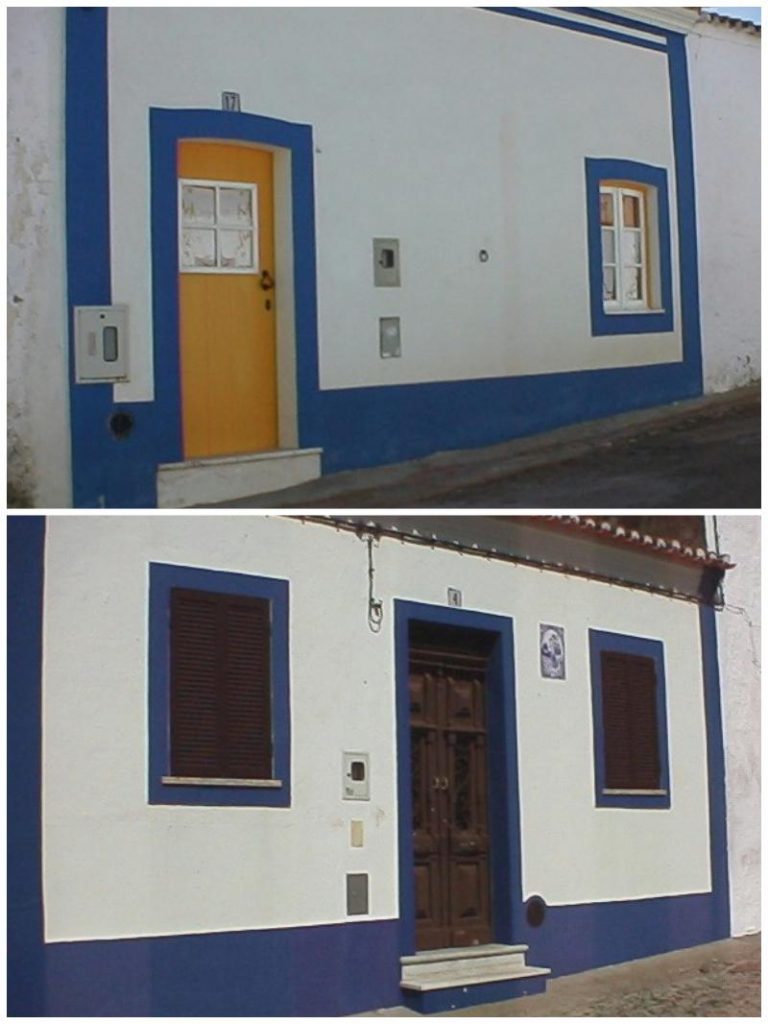
They also had a pousada in Alvito and the pousada was in the castle! This is what we had been looking for! We knew as soon as we walked in that this was the place for us. The woman behind the front desk was charming and offered to show us both a regular room, and their one and only “special” room, the Queen’s Bedroom. We took a look at both and came to our decision rather quickly; why stay in a monk’s cell, when you can sleep in the Queen’s bedroom? So we did!
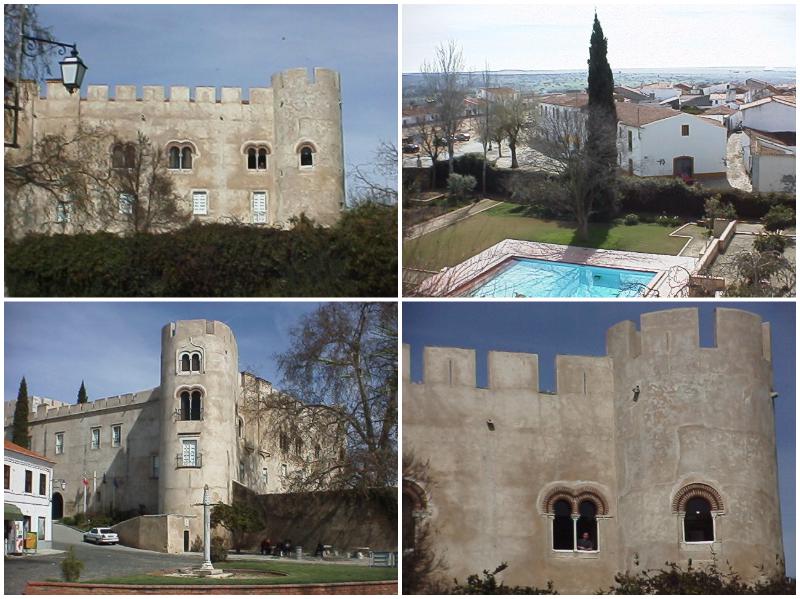
David insisted that even though the other regular rooms in the pousada were quite nice and a bit cheaper, we had to stay in the Queen’s bedroom because it was the same price as the other Pousada we were going to stay in, only way, way, better. Of course, along with this, he said something terribly romantic like, “Only the Queen’s bedroom for my Queen” or something like that. I think he secretly wanted to play King of the castle too.

So, the Queen’s bedroom, you ask? Well, it was enormous, with a twenty-five foot domed ceiling with plaster crest at the top over blue and white azulejos. It had ancient arched windows, with views of the countryside in two different directions and a four poster bed. Out of one window, we looked down into the formal garden and pool area where there were at least a dozen peacocks strutting around, including a few that were completely white. Every once in a while, one of the peacocks would spread his grand plumage and strut around trying to entice one of the females; unfortunately, it never seemed to work, poor bird.
The marble bathroom was in what was once the round corner tower of the castle. They sent us a complimentary bottle of Champagne and some fruit soon after we arrived. Breakfast was delivered to the door the next morning. If you look at the photo above our room was on the top floor, the two windows on the far right, a corner room. The single window in the tower was the bathroom. Many thanks to my Mother for the gift of this wonderful experience.
It turns out we were one of only four rooms occupied out of twenty that night. They had been full the night before, but today was Sunday. We ate in the virtually empty dining room and the food was simple but well prepared. They had great service by a well trained, and mostly female (a rarity in fine dining), staff, and good local wine.
The Pousada do Castelo de Alvito is located in the center of Alvito and impossible to miss.
After Alvito, we drove to Sagres which is another tiny town at the very southwestern-most tip of Portugal- the “end of the world”. On the way there we got pulled over by the police and David got a $50 ticket (which we had to pay on the spot) for passing another car in an illegal place (and in front of the cop).
Sagres is where Prince Henry the Navigator had his famous School of Navigation. This is where all the explorers like Magellan, Columbus, and Diaz embarked on their adventures when the area was considered the “end of the world” when the world was “flat”. It has a beautiful and dramatic coastline and we drove out to the very tip, the Ponta de Sagres. Here there are the remains of a 16th-century fortress and we arrived just in time to watch the sunset over the edge of the world.

Back in town, we found yet another empty little hotel, the Aparthotel Orquidea (8650 Vila Do Bispo, tel. 082 64257) which was thankfully cheap, 4250 esc including breakfast, and had a wonderful view of the port and the water. No telephone in the room, so no e mail. It was only a little creepy however, to know that we were the only residents in this big hotel, and the desk clerk went home at midnight. Putting our Bates Motel fears aside, we slept well and were on our way to Spain the next morning.
Helpful Guidebooks for Portugal:
Any post on this site may contain affiliate links. Thank you for supporting wired2theworld by using our links to shop, book hotels, or organize tours. If you use them, they cost you nothing extra but we may make a small commission that helps us to continue to provide helpful and free content.


